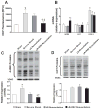Resveratrol Rescues Kidney Mitochondrial Function Following Hemorrhagic Shock
- PMID: 25895148
- PMCID: PMC4504763
- DOI: 10.1097/SHK.0000000000000390
Resveratrol Rescues Kidney Mitochondrial Function Following Hemorrhagic Shock
Abstract
Objective: Hemorrhagic shock may contribute to acute kidney injury (AKI) by profoundly altering renal mitochondrial function. Resveratrol (RSV), a naturally occurring sirtuin 1 (SIRT1) activator, has been shown to promote mitochondrial function and reduce oxidative damage in a variety of aging-related disease states. We hypothesized that RSV treatment during resuscitation would ameliorate kidney mitochondrial dysfunction and decrease oxidative damage following hemorrhagic shock.
Methods: Using a decompensated hemorrhagic shock model, male Long-Evans rats (n = 6 per group) were killed prior to hemorrhage (sham), at severe shock, and following either lactated Ringer's (LR) resuscitation or LR + RSV resuscitation (RSV: 30 mg/kg). At each time point, blood samples were assayed for arterial blood gases, lactate, blood urea nitrogen, and serum creatinine. Mitochondria were also isolated from kidney samples in order to assess individual electron transport complexes (complexes I, II, and IV) using high-resolution respirometry. Total mitochondria reactive oxygen species were measured using fluorometry, and lipid peroxidation was assessed by measuring 4-hydroxynonenal by Western blot. Quantitative polymerase chain reaction was used quantify mRNA from peroxisome proliferator-activated receptor γ coactivator 1-α (PGC1-α) SIRT1, and proteins known to mitigate oxidative damage and promote mitochondrial biogenesis.
Results: Resveratrol supplementation during resuscitation restored mitochondrial respiratory capacity and decreased mitochondrial reactive oxygen species and lipid peroxidation. Compared with standard LR resuscitation, RSV treatment significantly increased SIRT1 and PGC1-α expression and significantly increased both superoxide dismutase 2 and catalase expression. Although RSV was associated with decreased lactate production, pH, blood urea nitrogen, and serum creatinine values did not differ between resuscitation strategies.
Conclusions: Resuscitation with RSV significantly restored renal mitochondrial function and decreased oxidative damage following hemorrhagic shock.
Conflict of interest statement
The authors have no conflicts of interest or financial disclosures.
Figures





References
-
- Evans RG, Gardiner BS, Smith DW, O’Connor PM. Intrarenal oxygenation: unique challenges and the biophysical basis of homeostasis. Am J Physiol Renal Physiol. 2008;295(5):F1259–70. - PubMed
-
- Chertow GM, Burdick E, Honour M, Bonventre JV, Bates DW. Acute kidney injury, mortality, length of stay, and costs in hospitalized patients. J Am Soc Nephrol. 2005;16(11):3365–70. - PubMed
Publication types
MeSH terms
Substances
Grants and funding
LinkOut - more resources
Full Text Sources
Medical

